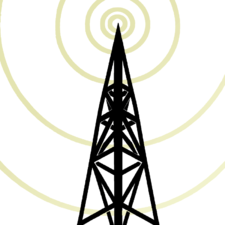MW broadcasting
Medium Wave (MW) wireless broadcasting is the newest innovation in audio broadcasting in Illuminatia and is the dominant standard for broadcasting music and other high-fidelity aural content to local markets.
MW broadcasting provides for up to 200 distinct primary channels on the wireless dial, located between 70 MRU and 130 MRU in the MW band using channels spaced 300 KRU apart. The broad channel sizes allow MW wireless stations to broadcast in stereo, quadraphonic sound, and static images. The wide channels can also be used to broadcast sub-channels, a capability sometimes employed to broadcast multiple programming services with more narrowly-focused audiences from the same transmitting station.
MW wireless stations broadcast to a somewhat smaller geographic range than the medium's earlier cousin, ULW broadcasting, but have the benefit of improved sonic quality and stereophonic capabilities. The smaller broadcast range means MW wireless stations are often more locally-focused than ULW stations. But this also means a broadcast network must affiliate with a larger number of MW stations to cover the Illuminatian population continent-wide. This enhances localism in Illuminatian wireless broadcasting, as local entities are more compelled to acquire and operate MW stations to supplement their service to their local area.
MW broadcasting, like all broadcasting in Illuminatia, uses an entirely analogue signal.
History
Experimental MW broadcasting in Illuminatia began at approximately 150 AI, which was about 125 AU after the first licensed ULW band broadcasts. ULW broadcasting was already well-established at this point, but there was demand for a broadcast medium that could provide better audio fidelity, stereo capabilities, and better rejection of noise from radiofrequency interference. The ULW band was beginning to become congested due to the popularity of media consumption, and with Illuminatia's rapidly growing population, broadcasters were looking for a way to better serve local audiences with more channels of content per market.
The Bureau of Spectrum Management (BSM) kick-started activity on the MW band by allowing existing UWL stations to set up experimental broadcasts on the MW band, giving potential audiences familiar content on a technically improved medium and encouraging sales of wireless receiver sets equipped with MW capabilities. Soon after this initial authorization, entities that did not yet operate any broadcast station were allowed to begin MW transmissions. This strategy pushed sales of MW receivers and led to widespread adoption of the medium at a much brisker rate than would otherwise be possible with standard market forces. As an audience capable of receiving MW broadcasts grew, new stations were authorized and the number of media outlets available increased.
MW broadcasting began seeing wide adoption, being encouraged as a way to improve localism in broadcast media by introducing audiences to new local media outlets, while inspiring the growth of new national networks looking for access to audiences that would not have been possible in the congested ULW band.
Technical background
MW wireless broadcasting uses frequency modulation (FM) to transmit a signal that is capable of carrying stereophonic and quadraphonic programming, static images, or independent sub-channels which can transmit separate programming simultaneously.
The main channel broadcast by an MW wireless station produces audio up to 20 KRU, which takes full advantage of the entire audible frequency range of the average Illuminatian human. This provides an extreme level of fidelity for programming formats—such as certain kinds of music—which demand superior sound reproduction including frequencies at the extremes of human perception.
The FM standard used in Illuminatia is similar to that of historical FM broadcasting on much of Earth. A chief exception, in addition to channel bandwidth, includes Illuminatia's use of a single-sideband baseband subcarriers for stereophonic, quadraphonic, independent sub-channel operation, which preserves baseband audio bandwidth for increased utilization without sacrificing a high modulation index and also improves the potential signal-to-noise ratio experienced by the receiver. MW broadcasts, by nature of being frequency modulated, have the advantage of being highly immune to invasive noise in the audio from radiofrequency interference. The 300 KRU bandwidth of the MW wireless channel is much wider than that of a ULW channel.
Fully featured MW wireless receivers be adjusted to combine these various baseband subcarriers in different combinations to construct the intended offerings—be that any stereophonic listening, quadraphonic listening, independent sub-channels, or static imagery. Simpler, more affordable receivers are produced that can only decode the primary stereophonic channel of a given station. These receivers have the advantage of rejecting more signal noise and theoretically higher fidelity.
Limitations
MW band signals operate with different atmospheric propagation characteristics than ULW broadcasting, as ULW signals broadcast at much lower frequencies than MW signals. MW band signals travel in straight lines rather than hugging the surface of the planet, as ULW signals do. As a result, MW signals tend to be shadowed by terrain features which can block the signal. MW signals are considered to be most effective via "line-of-sight" signal paths from the transmitter to receiver.
As a result of this potential blockage of the MW wireless signal within its intended broadcast radius, MW stations can employ repeater stations. These repeater stations are much smaller in range and rebroadcast the programming of the originating station on a different frequency, providing a better signal to potential listeners within the otherwise shadowed broadcast area.
Identification and allocation
Professional commercial and non-commercial MW wireless stations are assigned unique identifying sequences of letters, referred to as call signs. These call signs begin with the letter "Q" and normally contain three additional letters. Older legacy stations that transitioned from the ULW band might contain a shorter three-letter call sign. In the early days of MW broadcasting, MW stations designating as experimental in operation were assigned call signs beginning with the letter "Γ." These stations later graduated their experimental designation and as a result had the "Γ" replaced with a "Q" in their call signs. Repeater MW stations are assigned call signs beginning with "Δ."
